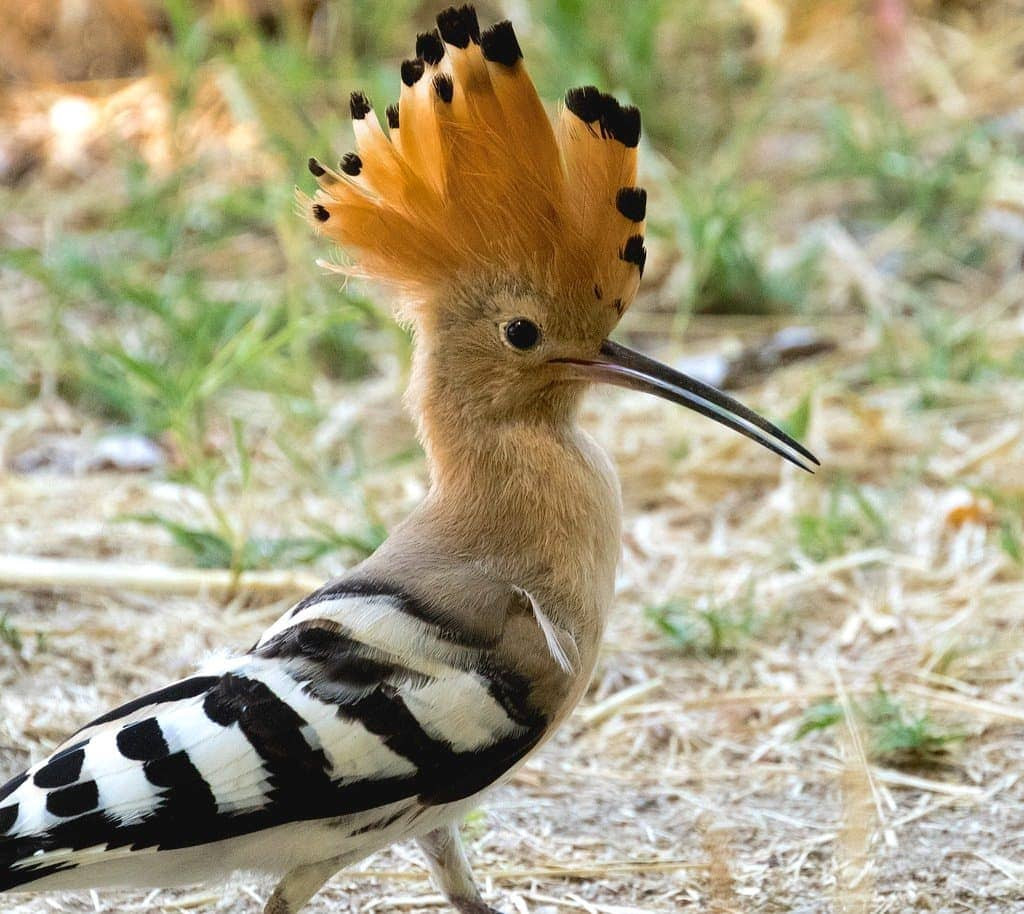Explore the allure of the hoopoe, from its meaning in ancient superstitions to its role in Sufi legends. With its iconic crest and unique abilities, this bird has captivated civilizations through its connection to the divine and mystical realms.
Superstitions and Characteristics of the Hoopoe Bird
The Hoopoe, the National Bird of Israel
The hoopoe, recognized as the national bird of Israel, wears a crown but displays no arrogance. It can be found in various places and symbolizes wisdom. This migratory bird, the size of a large thrush, arrives in Palestine in the spring.
This bird has feathers that form a semicircular crest on its head. It makes nesting easier by choosing walls and crevices. It values gender equality: both males and females are beautiful and share responsibilities in raising their young. The female incubates 6 to 7 eggs for two weeks in late spring or early summer, while the male provides her with food.
The hoopoe is also found in Europe, Eastern countries, Russia and North Africa from April but migrates to Central Africa, South Africa, or India by late August.
Distinctions and Customs of the Hoopoe
It is distinguished by its long beak and a crest of feathers, which the male especially displays during courtship, offering the female a worm, a spider, or a small lizard. The habit of seeking insects by stabbing its beak into the ground led some civilizations to associate this bird with the underworld and the afterlife. The ancient Minoans of Crete depicted it in tombs and temples.
Due to the dirtiness of its nest and its diet of worms and insects, it was considered impure in some ancient cultures, while in Egypt it symbolized filial piety and appears in popular stories from the Talmud.
In ancient times, the hoopoe was the subject of many superstitions, sacred in ancient Egypt and a symbol of virtue for the Persians. According to Arab mythology, it is a magical bird that brings happiness, love and luck. It was believed that whoever stared at it would gain weight, but those who looked at its belly would reconcile with their enemies. Its presence often indicated good luck.
Mysticism and Magical Protection of the Hoopoe
It is believed to make its nest invisible. In the past, merchants carried a hoopoe’s head in their pockets to avoid deception. It protects against the evil eye and exorcises spells. Its blood is used to write enchantments. Its eyes can uncover hidden treasures.
In Morocco, consuming its heart awakens an interest in religious studies. Using a dried wing as a bookmark supposedly improves success in studies. Its beak is useful for writing magical formulas and its brain is a main ingredient in ointments and magical potions.
The hoopoe is often associated with the arrival of spring. Shepherds in France believe that hanging the dried tongue of a hoopoe around the neck helps recover lost memory. If the hoopoe sings insistently while grapes are being pressed, it is a sign that the harvest will be excellent that year. In Spain, witches used this bird in their potions, generally with positive intentions, such as improving intellectual sharpness or strengthening moral integrity.
In Islam, the hoopoe is linked to King Solomon (Prophet Suleiman for Muslims), known for communicating with animals. The hoopoe, as the king’s messenger, brought him news of his beloved, the Queen of Sheba and her splendid kingdom.
The Hoopoe and Its Varied Reputation
In Jewish tradition, the hoopoe is listed as one of the “unclean birds” in the Torah, specifically in the book of Leviticus. This classification has implications for dietary practices, as kashrut laws prohibit the consumption of birds considered unclean. The inclusion of the hoopoe in this category may be due to several factors, such as its feeding habits or behavior, although specific reasons are not detailed explicitly in the sacred texts.
During the Middle Ages, the perception of the hoopoe in European culture was predominantly negative. It was attributed demonic and malignant connotations, likely due to its unusual appearance and behavior. These beliefs were reflected in the literature and folklore of the time, where it was often used as a symbol of immorality or corruption.
In Spain, particularly in La Mancha, the hoopoe is known as “cuquillo,” a name derived from its distinctive call “up-up-up.” The association of this bird with bad odor is part of local folklore and the expression “you smell like cuquillo” is used to indicate an unpleasant situation or person. This colloquial usage reflects how the cultural perception of a species can vary significantly from one context to another, influenced by a mix of ancient religious beliefs and everyday observations.
The varied reputation of the hoopoe, from a religious context to popular folklore, illustrates how animals can be imbued with cultural and symbolic meanings that go beyond their biological characteristics.
Myths and Legends of the Hoopoe
The myth of the hoopoe in Farid-ud-Din Attar’s “The Conference of the Birds” is one of the most fascinating examples of how this bird has been imbued with symbolic meaning across various cultures. Written in the 13th century, this Sufi poem is a profound allegory about the spiritual quest and enlightenment.
In this work, the hoopoe acts as a guide for thirty birds on their pilgrimage in search of the Simorgh, a mystical being. Throughout the journey, the birds face numerous challenges and overcome obstacles, symbolizing the spiritual trials that seekers must surpass on the path to profound understanding.
At the poem’s conclusion, a metaphorical twist unfolds: the birds realize that “Simorgh” reflects their own essence, embodying the Sufi belief that the divine truth they pursue is already within them. This revelation transforms “Simorgh” into “si morgh” or “thirty birds” in Persian, underscoring the idea that the spiritual journey is truly an inward quest.
In this context, the hoopoe symbolizes not only guidance on the spiritual path but also the ability to reveal the invisible and mediate between the earthly and spiritual worlds. Its role as a bearer of truth and prudence highlights its importance as a symbol of wisdom and enlightenment in Sufi mysticism. This tale exemplifies how a simple bird can be elevated to an almost prophetic status within a rich fabric of myths and spiritual beliefs.
Why Does the Hoopoe Have a Crest of Golden Feathers?
According to this beautiful Arab legend popularized by the Israeli poet Hayim Nahman Bialik, the hoopoe’s crest of golden feathers has a magical and significant origin.
The story tells how the hoopoes, through their cunning and sacrifice, earned a special place in the heart of King Solomon, a historical and biblical figure renowned for his wisdom and connection to extraordinary stories and fables.
King Solomon, known for his great wisdom and magical powers, is a central character in many Jewish, Christian, Muslim and Arab legends. In many of these narratives, Solomon has the ability to communicate with animals and control magical creatures, as reflected in the story of the hoopoe.
Lessons of Loyalty and Wisdom: The Hoopoe’s Golden Crest in the Legend of Solomon
When the hoopoe and its flock saved Solomon by creating a cloud with their bodies to shield him from the sun, they demonstrated not only their intelligence but also their loyalty.
King Solomon’s gratitude is evident in his promise to grant any wish the birds might have. Opting for a crest of golden feathers, the hoopoes expressed their desire for beauty and distinction—a feature to distinguish them from all other birds.
Solomon’s proposal to revise their wish if they later deem it impractical adds wisdom and foresight to the narrative, qualities often linked to him. This emphasizes the need for careful consideration of wishes, suggesting that even gifts from such a revered figure require thoughtful reflection and prudence.
This legend not only explains the characteristic physical trait of the hoopoe but also weaves the rich variety of interactions between humans and animals that is common in many cultural traditions, demonstrating how animals can be revered, respected and rewarded for their actions.
In summary, the hoopoe not only beautifies the skies but also enriches our stories and beliefs. Its legacy in mythology and nature highlights the interconnection between humanity and the animal kingdom, teaching us about wisdom and spirituality.
Sorana R




